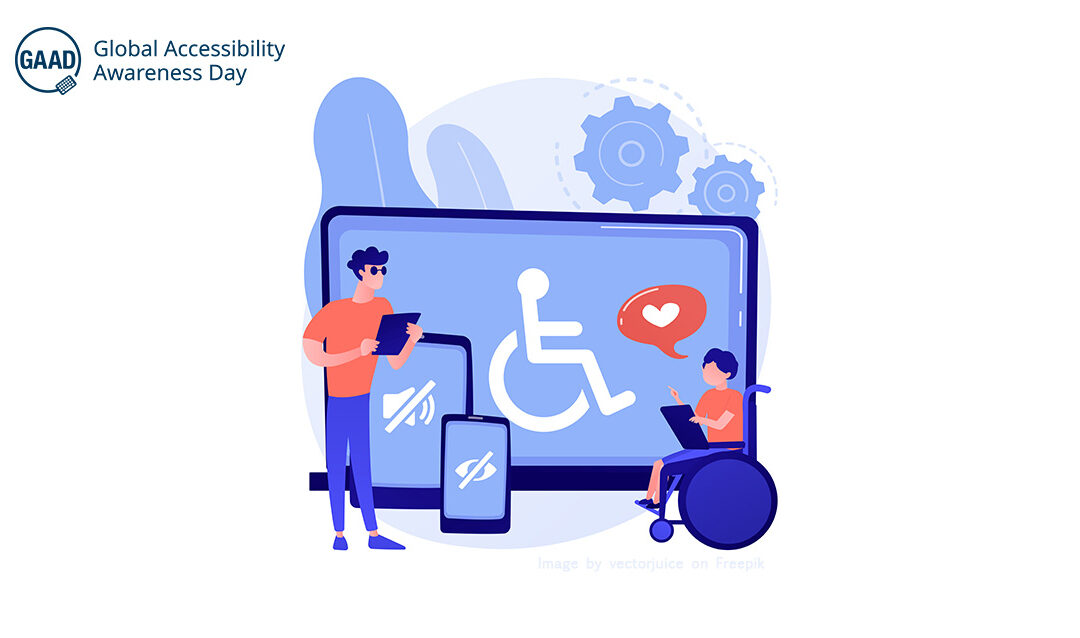The importance of web accessibility
Today is the 12th Global Accessibility Awareness Day (GAAD)! Consequently, it is the perfect opportunity to look at website development and digital inclusion for people with disabilities. Everyone should be able to access and enjoy the website you’ve put all your hard work into.
Accessibility has been a focal point in our work for the past few months. We have dedicated many hours into going back and checking the accessibility of several websites, performing numerous accessibility journeys to see how different people might experience the website. You might not realise what a physical impairment like blindness or cognitive disabilities can have on someone experinencing your site. As a developer, you build your website with clean coding, but often it seems to be the smallest things which are stopping your site from being Web Content Accessibility Guidelines (WCAG) compliant. That gorgeous colour palette you chose? Does it meet the minimum contrast ratio? Or that banner than you spent so long designing – how might a visually impaired user experience that if you forgot to add alt text to the image. These are just two of the common mistakes developers make when creating accessible websites.
It is important to understand that there are a variety of ways in which disabled people access digital products. This includes using a screen reader; tabbing through webpages with a keyboard rather than using a mouse; requiring contrast mode, especially on highly decorative pages; and using captions for videos. It is important that you design based around inclusivity, and ensure that all users, no matter the disability, are able to access your site.
As developers it is all to easy to get lost in the creation-side of web development, without thinking about user experience. This plugin for Google Chrome allows you to experience your website with a range of simulated disabilities. We would recommend taking the time to go through your website (or get us to do it for you!) on an accessibility journey, and see how easily you can navigate it.
There are many benefits to having an accessible website
- Ensuring that all users can access your content. Especially people with disabilities, such as those who are blind, deaf, or have mobility impairments.
- Improving your website’s usability. An accessible website is easier to use for everyone, not just people with disabilities. This can lead to a better user experience and increased engagement.
- Boosting your search engine ranking. Search engines like Google rank websites that are accessible more highly. This can help you attract more visitors to your website.
- Avoiding legal liability. In some countries, it is illegal to discriminate against people with disabilities. By making your website accessible, you can avoid potential legal problems.
The downfalls of not having an accessible website are also significant
- Losing potential customers. Studies have shown that people with disabilities are more likely to shop online. By not having an accessible website, you could be losing out on potential customers.
- Damage to your reputation. Not having an accessible website can damage your reputation as a business. People may see it as a sign that you don’t care about accessibility, which can lead to negative perceptions of your brand.
- Legal liability. As mentioned above, in some countries, it is illegal to discriminate against people with disabilities. By not having an accessible website, you could be putting yourself at risk of legal action.
Overall, there are many benefits to having an accessible website and many downfalls to not having one.
The spending power of disabled users
Many companies seem to be using the cost of updating their websites as an excuse for not implementing the changes they need to make their website accessible. Here are some statistics on how many people are disabled in the UK:
-
16 million disabled people, that’s 1 in 4 people
-
23% working age adults are disabled
-
45% of pension age adults are disabled
-
40% of households have at least 1 disabled person
-
around 1.5 million people have a learning disability
-
estimated 1 in 10 people have dyslexia
-
estimated 2 million people are living with sight loss
-
12 million have hearing loss greater than 25dBHL
-
estimated 151,000 people use British Sign Language
This is a huge percentage of your potential clients who are going to require an accessible website. It is estimated that the online market for people with access needs it about £24.8 billion per year in the UK, and having an inaccessible website immediately alienates you from this market. Is that really a market you want to cut off?
Wanting to make your website more accessible?
If you are not sure how to make your website accessible, there are a number of resources available to help you. The Web Accessibility Initiative (WAI) is a great place to start. WAI provides a number of resources, including guidelines, tools, and training, to help you make your website accessible. Some of the most important things to include are:
- Well-labeled images. All images on your website should have descriptive alt text so that people who cannot see the images can still understand what they are about.
- Keyboard navigation. Your website should be easy to navigate using only a keyboard. This is important for people who cannot use a mouse or trackpad.
- Contrasting colours. The text and background colours on your website should have enough contrast so that they are easy to read for people with low vision.
- Timed content. If you have any videos or audio on your website, they should have captions or transcripts so that people who are deaf or hard of hearing can still understand the content.
By following these tips, you can create a website that is accessible to everyone. Or alternatively, contact Haywyre today to see how we can help you!
